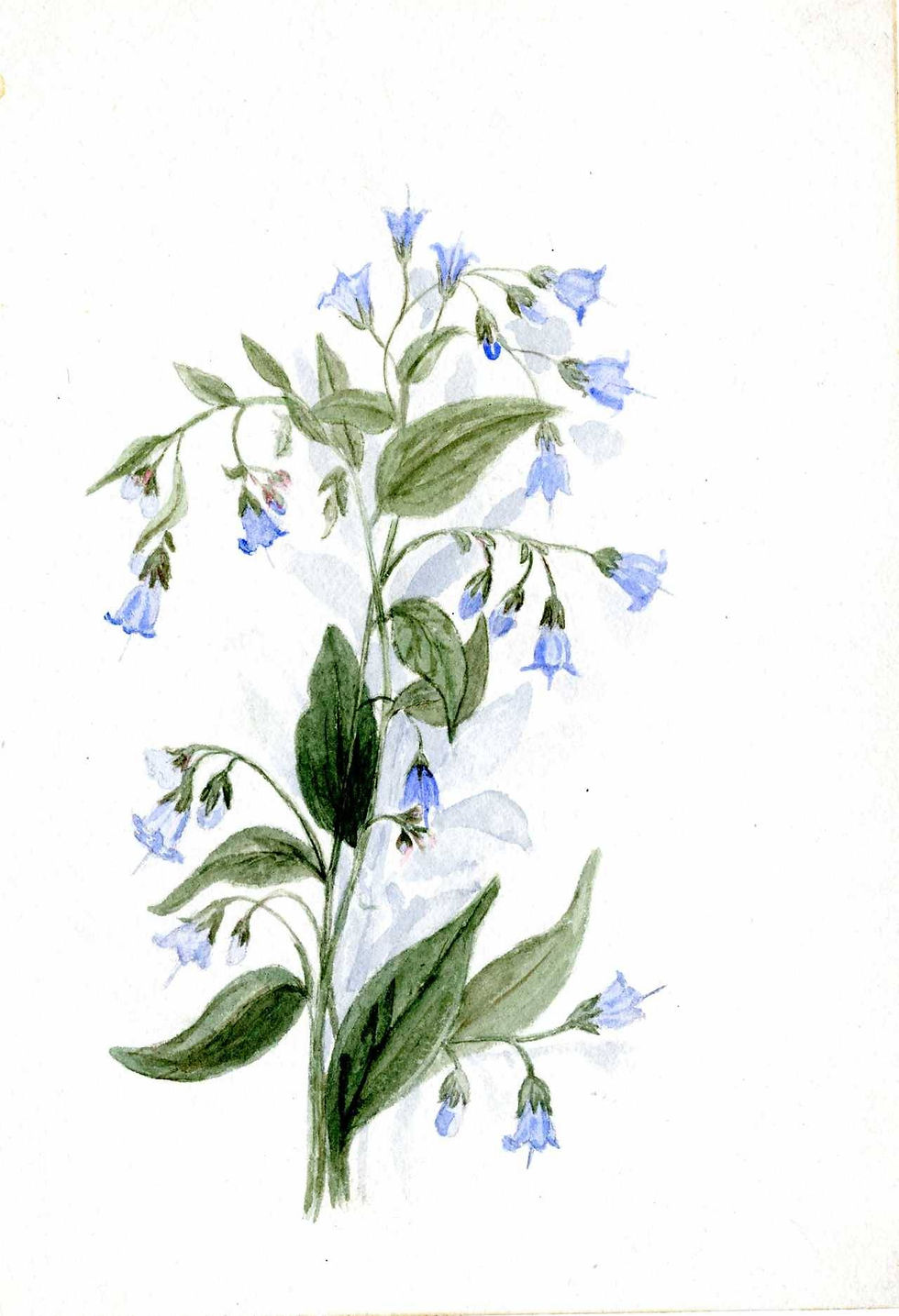Art, Suffrage, and Sara Annette Bowman
- LCHS

- Oct 4, 2022
- 5 min read
This article first appeared in the September/October 2022 edition of Home & Harvest magazine.
By Hayley Noble, LCHS Executive Director

This fall as the Latah County Historical Society celebrates the intersection of art and history at the McConnell Mansion, I wanted to highlight Sara Annette Bowman (sometimes referred to as just Annette). She is noteworthy for a myriad of reasons. Sara Annette Bowman was one of the first two women hired to teach at the University of Idaho. On the first day of classes on Oct. 10, 1892, Bowman, Nellie G. Brown, John E. Ostrander, and Franklin G. Gault were the University’s first faculty members. Secondly, Bowman was an accomplished artist. Hired to teach art at the University of Idaho, some of her works are in the University’s Special Collections and Archives and in the Latah County Historical Society Collection.
Born in Illinois in 1855, Bowman was trained as both a teacher and an artist, studying under Johannes Gelert, a noted Danish sculptor. She attended the Illinois State Normal University and the Davenport, Iowa School of Design. Bowman taught in Illinois and in Washington State before she was hired as the University of Idaho’s art instructor, eventually becoming the acting professor of art and design. She was with U of I until 1901, having taught all aspects of art. She then stayed in the area teaching at other local schools.
Not only was she a gifted teacher, but Bowman’s artistic talent is readily seen in her works. She was known for spending the summers sketching and painting the landscapes around Moscow. Her floral watercolors accurately capture the beauty and delicacy found in the region’s wildflowers. Not just her art remains in local collections. The University acquired her large collection of books to be donated to their student library, upon her death in 1931.

One of her most famous legacies is the “Silver and Gold Book.” When Chicago was chosen to host the 1893 World’s Fair, the entire country wanted to contribute. Most states in the Union at that time were allotted space to construct one building representing their state. Idaho’s fair building was a log cabin, filled with treasures from Idaho. The Ladies’ Columbian Club of Moscow consulted University of Idaho President Franklin Gault to come up with something to showcase the college town. Gault chose Bowman and Moscow jeweler R.M. Crockett to design and create the book for inclusion in the Idaho fair building. The silver and gold book is actually a jewelry box, shaped to look like a book. It is adorned with scenes from Idaho’s mining, lumber, hunting, and agriculture history, with a center engraving of the University of Idaho Administration Building. The book was handmade in New York, then shipped to Moscow for Crockett to add Ruby Creek rubies and opals from surrounding mines. The Columbian Club fundraised to pay for the book and displayed it for Moscow residents to view after the fair. They then donated it to the University. The book was in the President’s Office when in 1906, the Administration Building burned. The book was one of two items saved from the flames. It remains in the President’s Office in the “new” Administration Building.

Bowman was also a staunch supporter of women’s rights. While living in Moscow she attended a state convention as the Latah County delegate, organized by the Idaho Equal Suffrage Association, held on Nov. 20, 1895, in Boise. The Idaho Equal Suffrage Association, formed with help from the National American Women’s Suffrage Association, persuaded Idaho’s political parties to adopt women’s suffrage as part of their platforms leading up to the 1896 election. Additionally, she was chosen to be the Moscow representative on the Suffrage Association’s advisory board, working with the club’s officers. On September 18, 1896, Governor William McConnell signed a proclamation amending Idaho’s constitution to allow women to vote. Bowman’s work paid off; the measure passed in the election a few months later and women were granted suffrage in Idaho.

Some of the other details about Bowman’s life are fuzzy, but we do know that she never married, although her nephew, Frank, lived with her for a while. We also glean from newspaper articles that she had a strained relationship with the rest of her family. In 1900, when Bowman’s mother died, her brother accused her of influencing their mother and changing the conditions of the will, leaving out the brother. He brought these accusations to court, and the family drama played out in papers for all to see for years. The family found themselves in the news once more when Bowman’s father died and issues arose with the division of his farm between Bowman and her siblings. She died not long after that on July 24, 1931, in Wallace, Idaho at age 76.
She is remembered for her historic position as one of the first teachers hired at the University of Idaho, for being a talented artist, and a suffragist working for Idaho women to gain the vote. Her legacy of activism and art lives on in a county filled with artists and activists. Looking at Moscow alone, there is a thriving art community, evidenced through the city’s events like ArtWalk, artist vendors at various community markets and festivals, public art around town, multiple galleries, and groups, such as the Palouse Watercolor Socius. And that is just to speak of visual art. There are countless other organizations and communities surrounding performing, literary, culinary, and craft arts. The town’s motto is quite literally “heart of the arts.”
Art and history go hand in hand. Art is one of the many ways people can learn about the past. Art often depicts historical events and knowing the history of those events can shed light on the impacts, context, and answer questions. By looking at a work of art's symbolism, colors, and materials, we can learn about the culture that produced it. Art is a reflection of the society in which it was produced, allowing viewers to learn about that society. Moreover, depictions of similar events, when compared, provide varying perspectives that inform our understanding of the past. Lack of artistic expression or prevalence of only certain kinds of works also informs on censorship, prejudice, and other oppressive measures taken against artists or who commissions pieces. Understanding art and culture of the past helps us understand society in the present.
Bowman’s art is on display this fall as part of the “Art in the Archives” exhibit at the University of Idaho Library. LCHS also has a few of her works that you might see on display at the McConnell Mansion from time to time. Additionally, LCHS has tasked the county’s residents with creating art inspired by the McConnell Mansion. Those works will be part of the “McConnell Mansion Masterpieces” community art show on display in the McConnell Mansion from September 27 to December 16, 2022. Stay tuned for news of accompanying programming related to art and history this fall.

Keith C. Peterson, This Crested Hill: An Illustrated History of the University of Idaho, (Moscow, ID: University of Idaho Press, 1987), 28.
Sara Annette Bowman Portfolio. “Flowers and Fields Around Moscow.” Spec Col MG 5023. University of Idaho Special Collections. https://search.lib.uidaho.edu/primo-explore/fulldisplay?vid=UID&docid=CP71102358100001451&context=L.
Sandy Harthorn, and Kathleen Bettis. One Hundred Years of Idaho Art 1850-1950. A Centennial Exhibition and Catalog. (Boise, ID: Boise Art Museum, 1990), 77.
“Sara Bowman’s Library Arranged by University.” The Idaho Daily Statesman. February 7, 1932. NewsBank online database.
“1900 Census.” United State Bureau of the Census, 1900. T623, 1854 rolls. National Archives and Records Administration. https://search.ancestryinstitution.com/cgi- bin/sse.dll?indiv=1&dbid=7602&h=45135744&tid=&pid=&queryId=e59d32e924a3a724a37f6824c31dc753&usePUB=true&_phsrc=WGX166&_phstart=successSource.
“A Suit on a Will.” Quad-City Times. April 28, 1900. Newspapers.com. https://www.newspapers.com/clip/63034602/quad-city-times/.
“Court Rules in Estate Suit.” The Daily Times. December 22, 1916. Newspapers.com. https://www.newspapers.com/clip/63035220/the-daily-times/.
“Sister Bids In Father’s Farm in Court Sale.” The Rock Island Argus. February 1, 1930. Newspapers.com. https://www.newspapers.com/clip/63036331/the-rock-island-argus/.
“Woman Pioneer Taken by Death.” The Spokesman-Review. July 25, 1931. Newspapers.com. https://www.newspapers.com/clip/63034904/the-spokesman-review/.








Comments